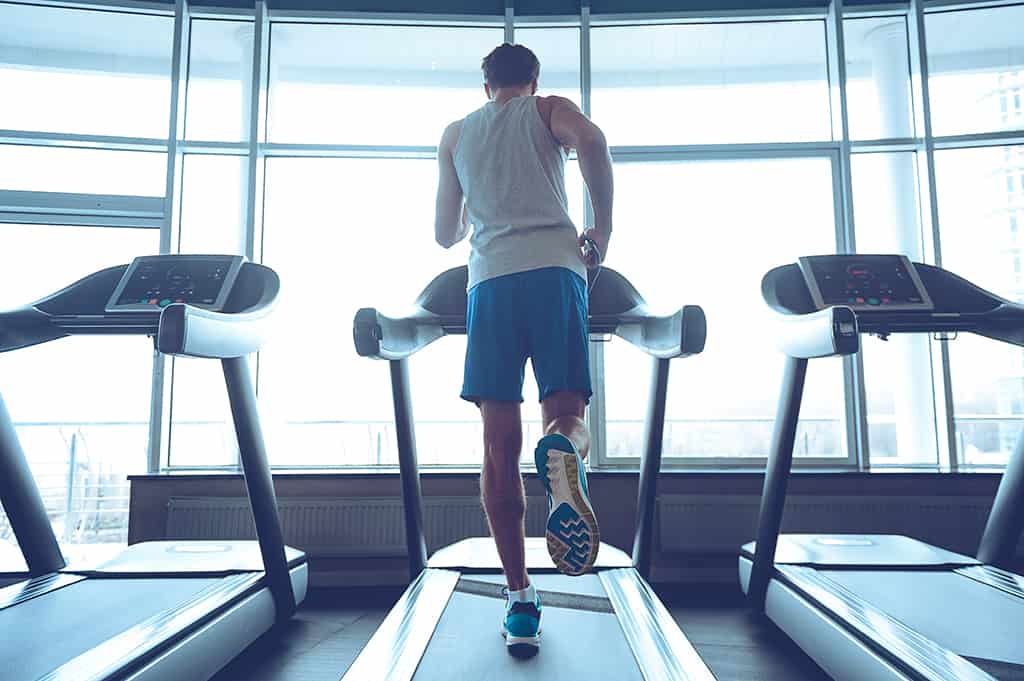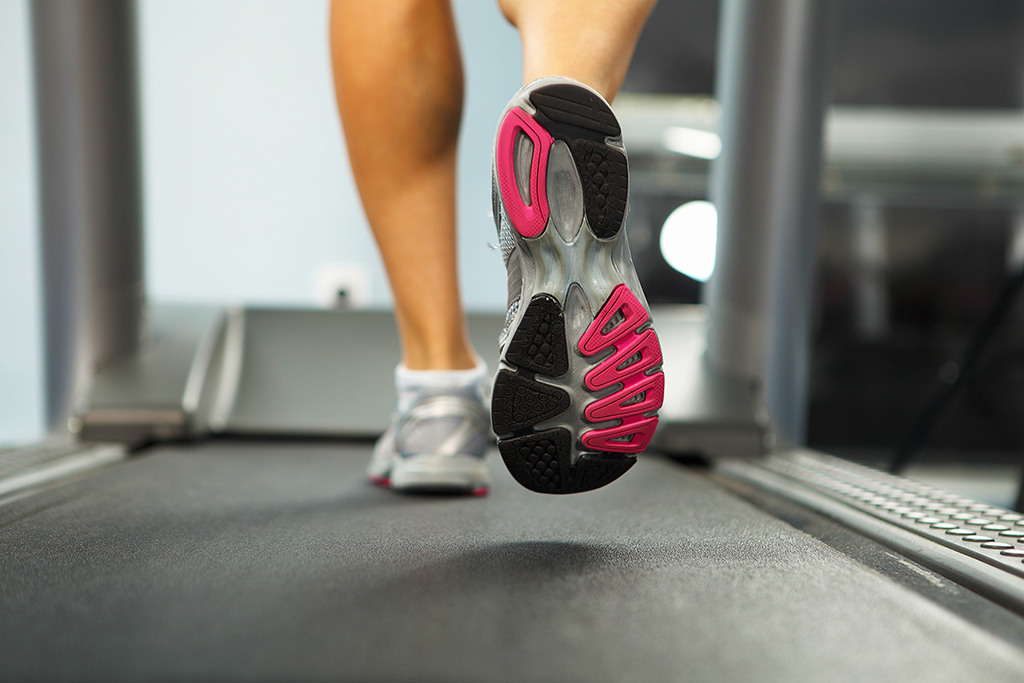Treadmills are one of the best ways to do cardio without leaving your house. They offer a variety of programs for different experience levels, types of workouts, and other customizable options.
They can help you improve your heart health, lose weight, build muscle strength and bone density, and improve your mental outlook. With that said, treadmills can also be extremely noisy.
That’s why people who live in apartments or condos – or folks who live in close quarters with roommates or family members – will find that their downstairs neighbors and living companions don’t love the treadmill as much as they do.
Fortunately, there are a number of quiet treadmills available. They can help you improve your cardiovascular system without compromising those around you.
The AirRunner is a manual treadmill that uses uses no electricity or motorized system, since the curved slat-belt running surface is self-powered; it runs as slow or as fast as you make it go with your legs.
This is a machine that’s built like a tank with a steel frame and steel handrails, and since it has the unique slat-belt instead of a traditional treadmill belt virtually no maintenance is required.
This type of treadmill doesn’t incline, and typically doesn’t have tons of bells and whistles. Surprisingly, though, the Assault treadmill does come with a full-featured, battery-powered control panel that monitors time, calories, distance, speed, watts and pace, lets you set interval programs and connects to a heart rate monitor, and provides Bluetooth connectivity as well.
It’s one of the quietest units you’ll find, lets you burn more calories than on a comparable motorized unit, and provides an amazing number of options for a manual treadmill. It’s expensive, but worth the price.
Here’s a more traditional motorized treadmill, from a respected company in the fitness world, Bowflex. Due to being motorized, it's a bit noisier than the AirRunner. It's powered by a 3.75 CHP motor capable of reaching speeds up to 12 mph.
However, the Bowflex motor makes a lot less noise than those on comparable treadmills. You can always run it at a lower speed if it gets too loud. On a related topic the base is heavy and solid, which minimizes the amount of structure-borne noise transmitted through the floor.
The BXT116 can incline through a range of 0-15°, with a wonderfully-large track that’s 20 inches wide and 60 inches long. The belt is comfortable to run on and is made of triple-ply material for longer life, and the computerized LED console is large and full featured with a wealth of programs.
The machine can be synched to an app for even more options and Bowflex’s JRNY personal coaching technology that creates personalized workouts that gives daily feedback. This is a powerful choice which also happens to be very quiet in operation.
The motorized T Series from NordicTrack comes in a number of different models (at varying price points), ranging from the smaller T 6.5S that tops out at 10 miles per hour and a 10° incline, to the top-of-the-line T 9.5S which can go 12 mph with a 12° incline.
The decks are all 20” wide, although the 6.5S deck is just 55 inches long (compared to 60” on the other models). The motors become more powerful (between 2.6 and 3.6 CHP) and the consoles become larger and more feature-rich, as you move up in models.
The two highest-level models, the 8.5S and 9.5S, are not only self-cooled but feature motors with special noise-reducing technology.
There are plenty of programs available through the console, and thousands more can be used through the Bluetooth-connected app, along with live interactive training and daily workouts (membership fee required, naturally). This one is less expensive than the Bowflex, but still a very good option.
There are actually three models in this series from Horizon. We’ve chosen the high-end T303 because of its longer running deck (60” x 20”), and because of its enhanced HIIT console which doesn’t have an enormous number of pre-set programs, but connects via Bluetooth for a terrific interactive experience.
The 3.0 CHP motor on this machine is very quiet, and the construction is so solid (creating very little structure-borne noise) that the company backs the frame and motor with a lifetime warranty. Typically if a company backs a lifetime warranty on parts, it's bound to last.
The T303’s maximum speed is 12 mph, maximum incline is 12°, and the price is reasonable for a high-quality treadmill which should last for a very long time.
Our budget choice specifies its ability to fold up in its name, but that doesn’t make it unusual; most of the machines on this list fold for storage.
What does make it unusual is that it’s a very good treadmill for about one-third the price of the Horizon – and that it’s extremely quiet for an inexpensive, motorized (2.5 CHP) unit. A proprietary anti-shock system also reduces the amount of noise transferred through the floor.
As could be expected, performance isn’t quite as robust as you’d find in a higher-end model. The highest speed you can reach is 8.5 mph, the incline has to be set manually (three choices) instead of electronically, and the running deck is somewhat short and narrow at 53 x17 inches.
Even so, there are more than a dozen pre-set workout programs along with all of the monitoring functions you’d expect from a treadmill’s LCD console. It’s a sturdy unit – and a very good buy.

All treadmills produce some form of noise. Your feet hitting the deck is likely to result in a squeak and/or vibration due to footfalls. The belts, bearings and other components are mechanical in nature and are apt to squeak as well.
All of these elements contribute to both airborne and structure-borne noise. This results in noise both in the room it's being used as well as adjoining spaces.
There are ways to limit the “damage,” though. Noise output is usually a result of the overall construction and the mechanical/moving-parts of the treadmill.
A lot of the noise generated by a treadmill is created when the machine rocks, shifts from side to side, or creaks as you walk/jog/run on it.
Many of those sounds can be mitigated by the engineering of the treadmill. For instance, many treadmills are often built with a feature designed to make their use easier on your feet, legs and joints: a floating or suspended deck attached to the frame with rubber or elastomer material. This is similar to how structures are decoupled in soundproofing applications which help to prevent noise output.
In effect, these are essentially shock absorbers (many are adjustable to fit your taste), and they do more than just give you a comfortable run. They also absorb some of the noise created by the treadmill’s operation, making a suspended deck worth searching for if you want to minimize the noise your machine makes.
One other important feature of a quiet treadmill is anti-vibration rubber feet. They not only hold the unit in place, but minimize the vibrations which are transmitted through the floor and even the building’s foundation. To ameloriate this effect you can also place a layer of mass-loaded vinyl or sound absorbing material beneath the treadmill to absorb impact sound.
In essence, the minimum specifications you should be after are:
Just like automobiles, vehicles with bigger motors typically generate more noise. However in terms of treadmills, you have two options: manual or motorized.
A manual treadmill is powered by the user. In order for the treadmill belt to stay in motion, the user must continue walking/jogging/running. As a result, these treadmills require extra effort from the user.
Typically, a manual treadmill is more cost effective and requires no electricity. With that said, they also tend to have less features.
There are two types of manual units, hydraulic and magnetic. The primary difference between them is how the resistance that you “run against” is created, via hydraulic pistons or large magnets.
Each of these treadmills puts more stress on your joints than a motorized model, and requires more effort in return for a “less-realistic” run. They’re also less likely to have bells and whistles like fancy control panels and touch screens. They’re quiet, though, and also a lot less expensive than their motorized counterparts.
As the name implies, these treadmills use a drive motor to power the treadmill mechanism. Looking at treadmill motors can be rather confusing.
Peak vs Continous Duty
There are two measures of motor power: peak duty horsepower (HP) and continuous duty horsepower (CHP). These numbers are important factors to consider because of how certain companies advertise their products leading to discrepancies.
Peak Duty Horsepower indicates the power potential of the motor (the highest power it's capable of operating at). With that said, treadmills can't sustain this power during use and will overheat.
Continuous Duty Horsepower is a more accurate measurement. This tells the user the power the motor can run at continuously for a 24 hour period.
Overall, look for a motor with at least a 1.5 CHP motor. If you plan to use your treadmill for running, use a 2.5 - 3.0 CHP motor. Your weight will also have an impact on motor requirements.
Keep in mind that RPM ratings should also be kept low to minimize noise output. You should always look for lower RPMs for optimal performance, torque, lower noise, and energy efficiency.

Treadmills are mechanical devices, so they need regular maintenance. When you neglect that annoying but necessary work, motors can get clogged with dirt or hair and run more noisily, belts can loosen and begin squeaking, or screws can come loose and leave parts vibrating. Inspecting, cleaning and lubricating a treadmill according to manufacturer recommendations will help your treadmill run as quietly as possible.
Believe it or not, it makes a difference where you set up your treadmill. Noise generated close to walls will bounce off them and be amplified, so a machine placed in a corner will sound louder. But unfortunately, the floors in the corner of a room are also most likely to squeak. Decide on your treadmill’s placement depending on the characteristics of your space.
One final tip: the type of shoes you wear while running makes a big difference. Hard street shoes will create a resounding “thud” every time your feet land, but soft, flexible running shoes will minimize noise and vibrations.
Just because you’re looking for a quiet unit, that doesn’t mean you should ignore other features.
Some of the questions to ask before buying:
How large is the machine, and will it fit into the space you have available? Is the belt long and wide enough for your needs?
You’ll need a little more space for running than walking; the belt should be 22” wide and about 55-60” long for running.
How fast will the treadmill go? (Of course, remember our earlier discussion of speed vs. noise.)
The average machine will reach speeds of 10-12 miles per hour, and a motorized treadmill should run at 2.5-3.0 CHP for jogging or running.
Does the treadmill incline?
Most good units will have an automatic incline of at least 10-15°.
Does the treadmill have pre-set workout programs? Is there enough variation in them to keep you interested and motivated? Can it connect to an outside fitness platform like iFit to expand the program options?
These programs can work as motivation. Being able to sync your workouts to an app or your phone can help to best your previous workout.
Can the treadmill be folded and easily carried for storage?
This is a common feature for a number of treadmills. If you have minimal space, being able to fold your treadmill prevents it from being a permanent fixture in your space.
Treadmills are a great way to improve your cardiovascular system. However, most treadmills will make ample amounts of noise that can affect the people who live above or below you.
A treadmill that ends up being used just as a clothes hanger won’t make any noise at all – but it will be the most expensive clothes hanger you’ve ever bought.

Snoringsource.com is a participant in the Amazon Services LLC Associates Program, an affiliate advertising program designed to provide a means for website owners to earn advertising fees by advertising and linking to amazon(.com, .co.uk, .ca etc) and any other website that may be affiliated with Amazon Service LLC Associates Program.